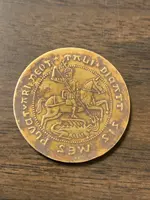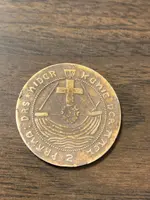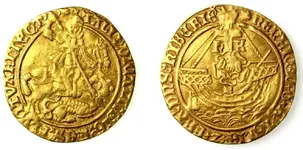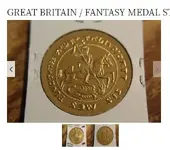Interesting. Never seen one of those before. The imagery is loosely borrowed from the English Tudor ‘George’ noble gold coin. This one is Henry VIII (1526-1529):
View attachment 2068524
I can’t read it all and, in some cases the letters are abbreviated Latin words which might be hard to interpret, but the reverse (with St George slaying the dragon) has a variation on the original legend for Henry’s coin. The letter that looks like a Greek ‘pi’ symbol is a mediaeval ‘A’ and the character that looks like a lower case ‘a’ is a mediaeval ‘C’.
So the reverse of Henry’s coin reads (in Latin): TALI : DICA : SIGnO : MES 'x FLVCTVARI : nEQVIT (Consecrated by such a sign the mind cannot waver). On yours there is at least the beginning of that as: TALI*DICA[TT] but it then goes off-piste with something like: SIS MES PLVCAT v ARI nE?T. Stumped on that.
The obverse for Henry’s coin (with ship, cross and Tudor rose) reads: hENRIC8 DI'x G'x R'+ AGL'+ Z + FRAnC'x DnS '+ hIBERnI (Henry the Eighth by the Grace of God King of England and France Lord of Ireland) but yours has been replaced by something entirely different that I can’t decipher.
It was common for prestigious English gold coins to inspire imitations in Europe with suitable adaptations… both for regular coinage and for jetons/tokens, and for centuries after the English originals were no longer in circulation. My feeling is that this a late 19th or early 20th Century brass continental token for use in card games and such rather than an earlier jeton in the sense of being used for accounting purposes.








